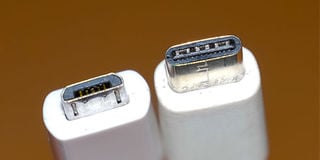TECH BREAK: The USB Type-C is the next big thing for smartphones

A Micro USB (left) and a USB Type-C. PHOTO| AUGUSTINE SANG
What you need to know:
- The takeaway is that just because a device has a Type-C connector, it doesn’t necessarily mean crazy fast data transfer speeds as marketers would have you believe.
You might have already come across the term USB Type-C and how smartphone marketers seemingly try to make a big deal out of it when trying to sell you a phone.
But what does it really mean for the consumer?
USB Type-C is a new type of Universal Serial Bus (USB) connector for digital devices used for data transfer data as well as charging. It has been around since 2015 but it's only now that we are seeing its wide adoption on smartphones, particularly those at budget levels.
The structure of this ‘new’ connector is rather different from the old Micro USB as depicted by the image above.
USB Type-C is backward compatible, which means you can plug the cable in whichever way without worrying about spoiling the port on your device, you’ll always plug it in the right way every first time.
The Micro USB can only go in one way and plugging it the opposite way will break the connectors. I know of people who have actually ended up damaging their phones’ ports just by plugging the Micro USB the wrong way.
This structural difference is USB Type-C’s greatest advantage over the Micro USB.
A major misconception about USB Type-C on smartphones, however, is that data transfer speeds are extremely high.
SPEED AND POWER
The USB Type-C simply refers to the physical connector shape or design; it is not a new standard.
That means a USB Type-C connector can either be USB 2.0 capable of 480Mbps, USB 3.0 capable of 5Gbps, USB 3.1 capable of 10Gbps or even a Thunderbolt 3 connector.
All of these are versions or standards that depict capabilities in terms of speed and power. Confusing, right?
Well, the takeaway is that just because a device has a Type-C connector, it doesn’t necessarily mean crazy fast data transfer speeds as marketers would have you believe, keep that in mind.
Does that mean there is less to gain in switching to Type-C? By all means no!
The point I'm trying to put across is that you shouldn't go for a new smartphone on the premise of a ‘faster’ Type-C connection without understanding the nitty gritty.
Smartphones generally have not yet fully tapped the potential of the USB Type-C. Most Type-C phones in the market today are still using the old USB 2.0 standards capable of just 480Mbps.
But with time, we should expect an increase in the number of flagship devices with faster USB 3.0. The Type-C port supports all the three standards (USB 2.0, USB 3.0, USB 3.1) and hence it makes it the port of the future.
Right now, however, it would appear that the only major upside that comes with the Type-C is in its design. The advantage of plugging in a cable to your device without worrying which side is up is enough to make it relevant.





